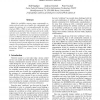718 search results - page 49 / 144 » Operational Semantics of Security Protocols |
IEEEARES
2006
IEEE
14 years 1 months ago
2006
IEEE
Distributed object systems for partitionable systems present a challenge, in that there is a trade-off between availability and consistency. Changes in one partition are not visib...
ISCI
2010
13 years 5 months ago
2010
Key agreement (KA) allows two or more users to negotiate a secret session key among them over an open network. Authenticated key agreement (AKA) is a KA protocol enhanced to preve...
ICDE
2009
IEEE
14 years 9 months ago
2009
IEEE
Over recent years there has been increased level of discussion on utility pricing for software. The focus of these discussions is to create new operating cost models where the unit...
ACSAC
1999
IEEE
14 years 6 days ago
1999
IEEE
Mainly for scalability reasons, many cryptographic security protocols make use of public key cryptography and require the existence of a corresponding public key infrastructure (P...
CRYPTO
2007
Springer
13 years 11 months ago
2007
Springer
Oblivious transfer (OT) is an essential building block for secure multiparty computation when there is no honest majority. In this setting, current protocols for n 3 parties requ...

